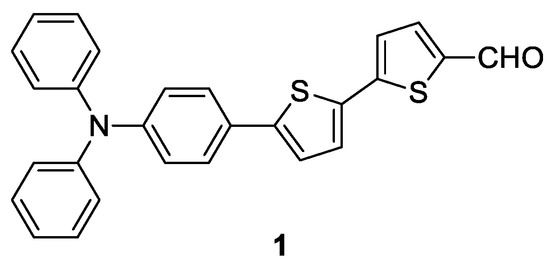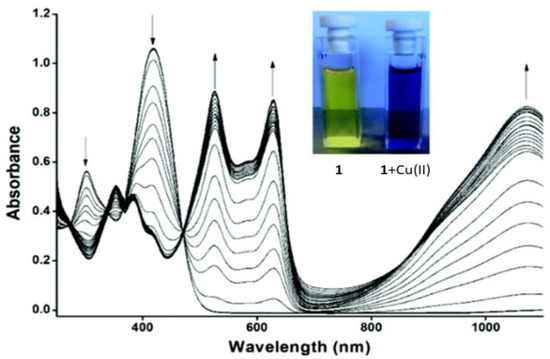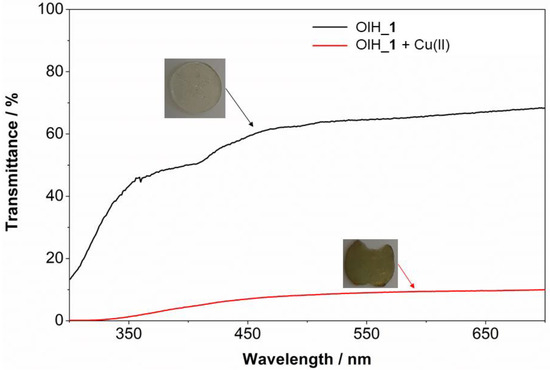Abstract
Organic–inorganic hybrids (OIH) are a versatile type of material that joins organic and inorganic moieties in a polymeric matrix and can be easily synthesized by the sol–gel method. OIH can be doped with chemosensors to yield an ion-sensitive polymeric matrix that can be used in the design of a more complex sensory device. Heterocyclic aldehydes show promising optical properties for supramolecular interactions with different ions through molecular recognition and changes in the optical signal. Cu(II) is a cation with biological and environmental relevance, being an appealing target for the design of chemosensors. Considering the group’s work on OIH materials and heterocyclic chromophores/fluorophores, this study reports the synthesis and characterization of an OIH based on Jeffamine THF-170 and 3-isocyanatopropyltriethoxysilane (3-ICPTES), doped with a previously synthesized heterocyclic aldehyde that features a naked-eye detection of Cu(II). Additionally, the OIH material shows color changes in the presence of Cu(II). Therefore, the obtained material shows promising properties to be used in the development of an optical fiber sensor for Cu(II) detection.
1. Introduction
Organic–inorganic hybrids (OIH) are a type of material that can be synthesized by the sol–gel method. These OIHs allow to intersect the polymeric nature of an inorganic matrix with the flexibility and versatility of organic moieties [1]. Sol-gel synthesis is a versatile method mainly due to the different variables that may influence the final properties of the obtained material, such as the type of precursors and solvents used, the pH, the temperature, reaction time, and drying treatment [2]. One of the remarkable advantages of sol–gel OIHs is that this type of material can be loaded with chemosensors, molecules sensitive to a certain analyte, allowing to obtain sensitive membranes.
Heterocyclic aldehydes are a versatile type of organic compounds that can be synthesized by methods such as Vilsmeier–Haack formylation and metalation, followed by the addition of dimethylformamide [3,4,5,6,7]. The carbaldehyde group, when linked to heterocyclic moieties, can originate π-conjugated push-pull systems with different optical applications, such as nonlinear optics [8,9], photodynamic therapy [10], dye sensitized solar cells [11], organic light emitting diodes [12] or optical chemosensors for cations or anions [13,14,15].
Cu(II) is one of the most abundant cations and plays an important role in both biological and environmental areas. The most common techniques for Cu(II) detection, such as inductively coupled plasma emission, atomic absorption spectroscopy or mass spectrometry are expensive and need specialized equipment and trained technicians. The development of a simple and fast sensor for Cu(II) is of relevant importance in a wide range of applications. Some chemosensors for Cu(II) detection have been reported, including aldehyde-based heterocyclic compounds [13,15,16,17].
Carrying on the research group’s investigation on OIHs and optical chemosensors [18,19], in this work, an OIH matrix, based on Jeffamine THF-170 and 3-isocyanatepropyltriethoxysilane (3-ICPTES) precursors, was synthesized. A previously synthesized heterocyclic aldehyde [13], which is highly selective to Cu(II), was loaded on the matrix. The obtained material recognizes the presence of Cu(II) through transmittance changes and naked-eye detection. Therefore, the OIH material shows promising properties to be used in the development of membranes for optical fiber sensor (OFS) functionalization for Cu(II) detection.
2. Experimental Section
2.1. Methods and Materials
Commercial reagents Jeffamine® THF-170 (Huntsman Corporation, Pamplona, Spain), 3-isocyanatepropyltriethoxysilane (3-ICPTES) (95%, Gelest, Morrisville, PA, USA) cetrimonium bromide (CTAB) (99+%, Acros Organis, Geel, Belgium), and acetonitrile (ACN) (Fisher Chemical, Hampton, NH, USA) were used as received. High purity deionized water with high resistivity (higher than 18 MΩ cm) obtained from a Millipore water purification system (Milli-Q®, Merck KGaA, Darmstadt, Germany) was used. Compound 1 was synthesized as previously reported [13]. UV–Vis absorption spectra (range 300–700 nm) for both pure and doped OIH films were recorded in absorbance and transmittance mode on a Shimadzu UV-2501 PC spectrophotometer.
2.2. Synthesis of Pure and Doped OIH
Synthesis of pure OIH films started with the addition of Jeffamine® THF170 dissolved in acetonitrile (ACN, 0.5 mL) and 3-ICPTES to a glass container using a molar ratio of 1 Jeffamine® THF170: 2 of 3-ICPTES. Pure and doped with compound 1 OIHs were synthesized. The solution was stirred for 20 min and then an aqueous solution of cetrimonium bromide (CTAB, 0.1 mL, 0.1 M) and an ACN solution of compound 1 (0.5 mL, 10−4 M) were added. The mixture was stirred until a homogeneous mixture was obtained, and the gels were casted into Teflon® molds, covered with Parafilm®, and placed in an oven (UNB 200, Memmert, Buechenbach, Germany). The containers were kept at 40 °C for 15 days to ensure the curing of the film and remaining solvent evaporation.
3. Results and Discussion
3.1. Synthesis of Pure and Doped OIH
A new OIH material, based on Jeffamine® THF170 and 3-ICPTES precursors was synthesized with the main goal of yielding a Cu(II)-sensitive layer with potential to be applied on an OFS. For that reason, a heterocyclic compound, based on an electron-donor triphenylamino group, a bithiophene π-bridge, and a carbaldehyde electron-acceptor group, previously synthesized by the group, was selected [13]. Compound 1 (Figure 1) shows a maximum absorption wavelength (λabs) of 419 nm, a maximum emission wavelength (λemi) at 577 nm and relative fluorescence quantum yield (ΦF) of 0.22 in acetonitrile solutions. Compound 1 is highly selective to Cu(II), with changes in the absorbance spectra as shown in Figure 2, with the appearance of bathochromically shifted absorption bands towards the limit of the visible and into the NIR region.

Figure 1.
Structure of compound 1.

Figure 2.
Spectrophotometric titration of compound 1 (5.0 × 10−5 mol L−1) upon addition of increasing amounts of Cu(II) (from 0 to 10 eq.) in acetonitrile, and respective color changes (adapted from [13]).
Synthesis of OIH started with the addition of 3-ICPTES to an ACN solution of Jeffamine® THF-170. Isocyanate group reacted with the terminal amine group of the polyetheramine to yield the sol–gel precursor. ACN was used as a solvent to be comparable with solution sensory tests of compound 1. The surfactant CTAB was used to increase the porosity of the material for the exchange of Cu(II) ions in further tests. CTAB was dissolved in water, which begins the hydrolysis and condensation reactions of the sol–gel method, to yield the polymeric matrix. The mixture was stirred until a homogeneous mixture (gel) was achieved and then the gel was casted in Teflon molds and cured for 15 days. The synthesis steps are schematized in Figure 3.

Figure 3.
Synthesis steps of OIH materials (pure and doped with compound 1).
3.2. Preliminary Sensory Tests of OIH Doped with Compound 1
The produced OIH material doped with compound 1 was submitted to a preliminary test to assess the selectivity of the membrane to Cu(II) ions. A round disk of the material, with 1 cm of ø, was immersed in an 10−3 M ACN solution of Cu(II). The disk changed its color to dark green/ brown, showing sensitivity to the presence of Cu(II). The material was analyzed by UV/Vis absorption spectroscopy before and after contact with Cu(II) solution and the transmittance spectra of the material are shown in Figure 4.

Figure 4.
Transmittance spectra for OIH doped with compound 1 (OIH_1) and the same material after being immersed on a Cu(II) (10−3 M) ACN solution (OIH_1 + Cu(II)).
Transmittance spectra of the material shows a high-transmittance (60-70%) zone from 700 nm to 450 nm. A band at around 420 nm is shown, from the inner absorbance of compound 1. After contact with Cu(II), the material loses its transparency and shows a transmittance lower than 10%. Further tests must be carried out to assess the number of equivalents needed to change the transmittance of the sample and compare with the interaction between compound 1 and Cu(II) in solution. Nevertheless, these results show the promising properties of the OIH sol–gel membranes for application on OFS for Cu(II) detection in aquatic environments.
4. Conclusions
An OIH sol–gel material, based on Jeffamine THF-170 and 3-isocyanatepropyltriethoxysilane (3-ICPTES) precursors, was synthesized. Heterocyclic aldehyde 1, which is highly selective to Cu(II), was used as a dopant on the OIH matrix to yield a Cu(II)-selective material. The solvent used was acetonitrile, to be comparable with solution sensory tests of compound 1. CTAB was used to increase the porosity and homogeneity of the OIH membranes. The material allowed naked-eye detection of Cu(II), and a major change in transmittance spectra was seen. Further studies will be conducted, focusing on the full characterization of the material by Electrochemical Impedance Spectroscopy, Fourier-Transformed Infra-Red spectroscopy, and Thermogravimetric Analysis. The material shows potential to be used in the development of functionalized OFS for Cu(II) detection.
Author Contributions
Conceptualization, R.P.C.L.S., S.P.G.C., R.B.F. and M.M.M.R.; methodology, R.P.C.L.S.; formal analysis, R.P.C.L.S., S.P.G.C., R.B.F. and M.M.M.R.; investigation, R.P.C.L.S.; resources, S.P.G.C., R.B.F. and M.M.M.R.; writing—original draft preparation, R.P.C.L.S.; writing—review and editing, S.P.G.C., R.B.F. and M.M.M.R.; supervision, S.P.G.C., R.B.F. and M.M.M.R.; project administration, S.P.G.C., R.B.F. and M.M.M.R.; funding acquisition, S.P.G.C., R.B.F. and M.M.M.R. All authors have read and agreed to the published version of the manuscript.
Funding
This research was funded by Fundação para a Ciência e Tecnologia (FCT) and FEDER (European Fund for Regional Development)-COMPETE-QRENEU for financial support through the Chemistry Research Centre of the University of Minho (Ref. CQ/UM (UID/QUI/00686/2019 and UID/QUI/00686/2020), project “SolSensors—Development of Advanced Fiber Optic Sensors for Monitoring the Durability of Concrete Structures”, reference POCI-01-0145-FEDER-031220, and a PhD grant to R. P. C. L. Sousa (SFRH/BD/145639/2019).
Institutional Review Board Statement
Not applicable.
Informed Consent Statement
Not applicable.
Conflicts of Interest
The authors declare no conflict of interest.
References
- Schmidt, H. New type of non-crystalline solids between inorganic and organic materials. J. Non-Cryst. Solids 1985, 73, 681–691. [Google Scholar] [CrossRef]
- Hench, L.L.; West, J.K. The sol-gel process. Chem. Rev. 1990, 90, 33–72. [Google Scholar] [CrossRef]
- Meth-Cohn, O.; Stanforth, S.P. The Vilsmeier–Haack reaction. In Comprehensive Organic Synthesis; Elsevier: Amsterdam, NL, USA, 1991; pp. 777–794. [Google Scholar] [CrossRef]
- Bird, C.W. Comprehensive Heterocyclic Chemistry II; Pergamon: Oxford, UK, 1996. [Google Scholar]
- Kurti, L.; Czako, B. Strategic Applications of Named Reactions in Organic Synthesis; Elsevier: London, UK, 2005. [Google Scholar]
- Rajput, S. The Synthesis of Heterocycles: Synthesis and Formylation of Heterocycles Using Vilsmeier-Haack Reaction; LAP Lambert Academic Publishing: Chisinau, Moldova, 2017. [Google Scholar]
- Smith, M.B.; March, J. March’s Advanced Organic Chemistry; John Wiley & Sons, Inc.: Hoboken, NJ, USA, 2006. [Google Scholar] [CrossRef]
- Raposo, M.M.M.; Sousa, A.M.R.C.; Fonseca, A.M.C.; Kirsch, G. Synthesis of formyl-thienylpyrroles: Versatile building blocks for NLO materials. Tetrahedron 2006, 62, 3493–3501. [Google Scholar] [CrossRef][Green Version]
- Youping, H.; Genbo, S.; Jianqiu, S.; Guiming, Y.; Rihong, J. New organic nonlinear optical crystals of indole-3-aldehyde. J. Cryst. Growth 1993, 130, 444–446. [Google Scholar] [CrossRef]
- Karges, J.; Heinemann, F.; Maschietto, F.; Patra, M.; Blacque, O.; Ciofini, I.; Spingler, B.; Gasser, G. A Ru(II) polypyridyl complex bearing aldehyde functions as a versatile synthetic precursor for long-wavelength absorbing photodynamic therapy photosensitizers. Bioorg. Med. Chem. 2019, 27, 2666–2675. [Google Scholar] [CrossRef] [PubMed]
- Fernandes, S.S.M.; Castro, M.C.R.; Mesquita, I.; Andrade, L.; Mendes, A.; Raposo, M.M.M. Synthesis and characterization of novel thieno[3,2-b]thiophene based metal-free organic dyes with different heteroaromatic donor moieties as sensitizers for dye-sensitized solar cells. Dyes Pigm. 2017, 136, 46–53. [Google Scholar] [CrossRef]
- Guo, K.; Gao, Z.; Cheng, J.; Shao, Y.; Lu, X.; Wang, H. Linear thiophene-containing π-conjugated aldehydes with aggregation-induced emission for building solid red luminophors. Dyes Pigm. 2015, 115, 166–171. [Google Scholar] [CrossRef]
- Okda, H.E.; El Sayed, S.; Ferreira, R.C.M.; Gonçalves, R.C.R.; Costa, S.P.G.; Raposo, M.M.M.; Martínez-Máñez, R.; Sancenón, F. N, N-Diphenylanilino-heterocyclic aldehyde-based chemosensors for UV-vis/NIR and fluorescence Cu(II) detection. New J. Chem. 2019, 43, 7393–7402. [Google Scholar] [CrossRef]
- Esteves, C.I.C.; Batista, R.M.F.; Raposo, M.M.M.; Costa, S.P.G. Novel functionalised imidazo-benzocrown ethers bearing a thiophene spacer as fluorimetric chemosensors for metal ion detection. Dyes Pigm. 2016, 135, 134–142. [Google Scholar] [CrossRef]
- Chebrolu, L.D.; Thurakkal, S.; Balaraman, H.S.; Danaboyina, R. Selective and dual naked eye detection of Cu2+ and Hg2+ ions using a simple quinoline-carbaldehyde chemosensor. Sens. Actuators B Chem. 2014, 204, 480–488. [Google Scholar] [CrossRef]
- Chakraborty, N.; Bhuiya, S.; Chakraborty, A.; Mandal, D.; Das, S. Synthesis and photophysical investigation of 2-hydroxyquinoline-3-carbaldehyde: AIEE phenomenon, fluoride optical sensing and BSA interaction study. J. Photochem. Photobiol. A Chem. 2018, 359, 53–63. [Google Scholar] [CrossRef]
- Barszcz, B.; Glowiak, T.; Jezierska, J. Crystal and molecular structures of eight-coordinate (CuN4O4) and six-coordinate (CuN4O2) Cu(II) complexes with 4-methyl-5-imidazole-carboxaldehyde or 1-benzyl-2-hydroxymethylimidazole, respectively: Spectroscopic and potentiometric studies. Polyhedron 1999, 18, 3713–3721. [Google Scholar] [CrossRef]
- Sousa, R.P.C.L.; Ferreira, B.; Azenha, M.; Costa, S.P.G.; Silva, C.J.R.; Figueira, R.B. PDMS based hybrid sol-gel materials for sensing applications in alkaline environments: Synthesis and characterization. Polymers 2020, 12, 371. [Google Scholar] [CrossRef] [PubMed]
- Sousa, R.P.C.L.; Figueira, R.B.; Gomes, B.R.; Costa, S.P.G.; Azenha, M.; Pereira, R.F.P.; Raposo, M.M.M. Organic–inorganic hybrid sol–gel materials doped with a fluorescent triarylimidazole derivative. RSC Adv. 2021, 11, 24613–24623. [Google Scholar] [CrossRef] [PubMed]
Publisher’s Note: MDPI stays neutral with regard to jurisdictional claims in published maps and institutional affiliations. |
© 2021 by the authors. Licensee MDPI, Basel, Switzerland. This article is an open access article distributed under the terms and conditions of the Creative Commons Attribution (CC BY) license (https://creativecommons.org/licenses/by/4.0/).